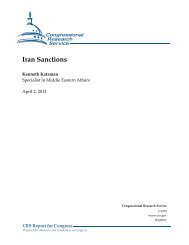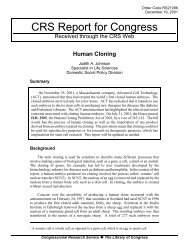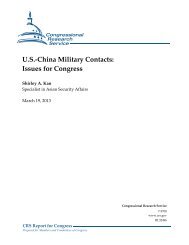North American Oil Sands: History of ... - The Air University
North American Oil Sands: History of ... - The Air University
North American Oil Sands: History of ... - The Air University
You also want an ePaper? Increase the reach of your titles
YUMPU automatically turns print PDFs into web optimized ePapers that Google loves.
<strong>North</strong> <strong>American</strong> <strong>Oil</strong> <strong>Sands</strong>: <strong>History</strong> <strong>of</strong> Development,<br />
Prospects for the Future<br />
Summary<br />
When it comes to future reliable oil supplies, Canada’s oil sands will likely<br />
account for a greater share <strong>of</strong> U.S. oil imports. <strong>Oil</strong> sands account for about 46% <strong>of</strong><br />
Canada’s total oil production and oil sands production is increasing as conventional<br />
oil production declines. Since 2004, when a substantial portion <strong>of</strong> Canada’s oil sands<br />
were deemed economic, Canada, with about 175 billion barrels <strong>of</strong> proved oil sands<br />
reserves, has ranked second behind Saudi Arabia in oil reserves. Canadian crude oil<br />
exports were about 1.82 million barrels per day (mbd) in 2006, <strong>of</strong> which 1.8 mbd or<br />
99% went to the United States. Canadian crude oil accounts for about 18% <strong>of</strong> U.S.<br />
net imports and about 12% <strong>of</strong> all U.S. crude oil supply.<br />
<strong>Oil</strong> sands, a mixture <strong>of</strong> sand, bitumen (a heavy crude that does not flow<br />
naturally), and water, can be mined or the oil can be extracted in-situ using thermal<br />
recovery techniques. Typically, oil sands contain about 75% inorganic matter, 10%<br />
bitumen, 10% silt and clay, and 5% water. <strong>Oil</strong> sand is sold in two forms: (1) as a raw<br />
bitumen that must be blended with a diluent for transport and (2) as a synthetic crude<br />
oil (SCO) after being upgraded to constitute a light crude. Bitumen is a thick tar-like<br />
substance that must be upgraded by adding hydrogen or removing some <strong>of</strong> the<br />
carbon.<br />
Exploitation <strong>of</strong> oil sands in Canada began in 1967, after decades <strong>of</strong> research and<br />
development that began in the early 1900s. <strong>The</strong> Alberta Research Council (ARC),<br />
established by the provincial government in 1921, supported early research on<br />
separating bitumen from the sand and other materials. Demonstration projects<br />
continued through the 1940s and 1950s. <strong>The</strong> Great Canadian <strong>Oil</strong> <strong>Sands</strong> company<br />
(GCOS), established by U.S.-based Sunoco, later renamed Suncor, began commercial<br />
production in 1967 at 12,000 barrels per day.<br />
<strong>The</strong> U.S. experience with oil sands has been much different. <strong>The</strong> U.S.<br />
government collaborated with several major oil companies as early as the 1930s to<br />
demonstrate mining <strong>of</strong> and in-situ production from U.S. oil sand deposits. However,<br />
a number <strong>of</strong> obstacles, including the remote and difficult topography, scattered<br />
deposits, and lack <strong>of</strong> water, have resulted in an uneconomic oil resource base. Only<br />
modest amounts are being produced in Utah and California. U.S. oil sands would<br />
likely require significant R&D and capital investment over many years to be<br />
commercially viable. An issue for Congress might be the level <strong>of</strong> R&D investment<br />
in oil sands over the long-term.<br />
As oil sands production in Canada is predicted to increase to 2.8 million barrels<br />
per day by 2015, environmental issues are a cause for concern. <strong>Air</strong> quality, land use,<br />
and water availability are all impacted. Socio-economic issues such as housing,<br />
skilled labor, traffic, and aboriginal concerns may also become a constraint on<br />
growth. Additionally, a royalty regime favorable to the industry has recently been<br />
modified to increase revenue to the Alberta government. However, despite these<br />
issues and potential constraints, investment in Canadian oil sands will likely continue<br />
to be an energy supply strategy for the major oil companies.











